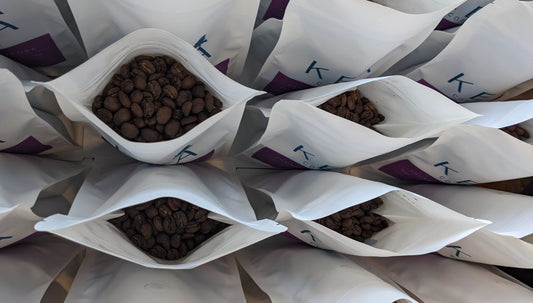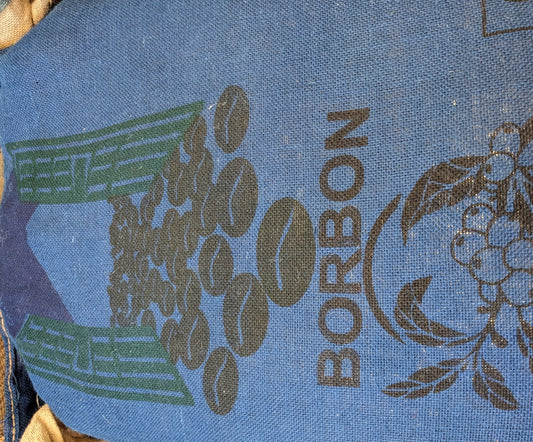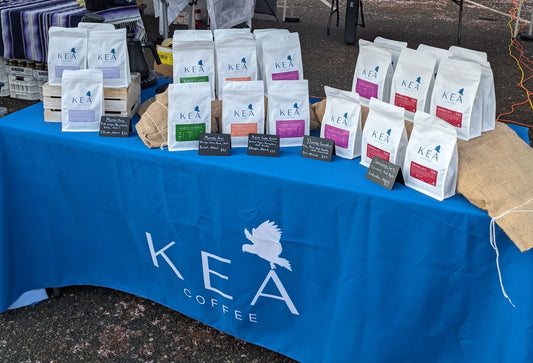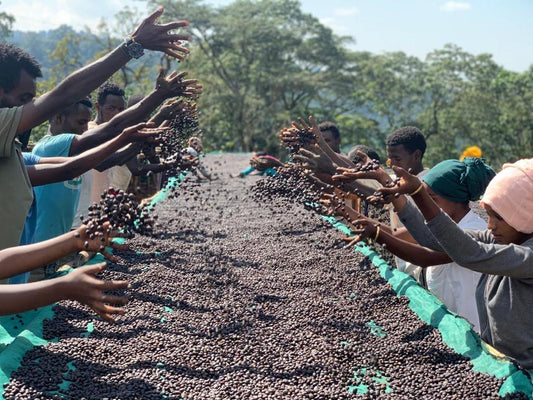Jump to:
Why does my espresso taste bitter?
Why does my espresso taste sour?
How often should I clean my espresso machine?
How do I clean and maintain my espresso machine?
What ratio works best for espresso?
What's the right grind size for espresso?
How can I dial in a coffee on espresso? What's a good approach to take?
What is a good extraction time for espresso?
Can I make espresso without an espresso machine?
Why is my puck soggy/wet?
No one likes a soggy puck.
And this is one of the most common questions we hear from people who are dialling in their espresso game.
A puck that's soggy and mushy often doesn't knock out cleanly.
That's ok if you're just making one shot at a time, but it's a huge pain to your workflow if you need to pull multiple espressos back to back.
That said, a soggy puck doesn't necessarily mean your espresso isn't dialed in.
You can still end up with great tasting espresso even though your pucks are messy.
So don't worry about it too much from a taste perspective, but if you wanna clean it up, here's the solution...
A soggy puck means that your dose of coffee was too small for the size of basket you're using in your portafilter.
If you dose too low for your basket size, there's more room for water to pool on top of the puck while you're pulling your shot.
When you stop the shot, that water that's still on top of the puck has nowhere to go. It'll just sit there and then gradually make its way through the puck (albeit slowly now that the pressure is all gone).
To fix soggy pucks: dose higher. Or use a smaller basket, if you want to maintain your dose.
Why does my espresso taste bitter?
A good, well balanced and well extracted espresso shot shouldn't be bitter.
Bitter espresso means your extraction went a bit too far, and you need to pull back a little.
Here's a really simplified way to think about extraction:
The first part of your shot is where you're extracting the most acidity. Those compounds are easiest to extract and will show up first.
Next is sweetness. As the shot continues, you'll start to pull out all of those lovely sugars and sweetness.
Depending on what you're looking for and what coffee you're using, the key to a good and well balanced espresso is figuring out how much of the sweetness part of the shot you want to pull, to balance out or enhance the acidity part.
If you push your extraction even further, that's when you start to extract bitterness.
So if your shots are tasting bitter: shorten your shot time to pull back your extraction.
You can do that by grinding slightly coarser. Or you might even want to keep your grind the same and reduce your time. Experiment with both and see what works best for you and what you prefer, as those 2 different solutions will do slightly different things to other components of the shot, like body and mouthfeel.
Why does my espresso taste sour?
Sourness in espresso is an interesting one.
Sometimes, sour tasting espresso means we need to work on increasing extraction. And we'll dig more into that in a sec.
But sometimes what we're perceiving as sourness is just the inherent acidity in the coffee that's used to make the espresso.
So if you're used to more traditional tasting espressos, then the first time you try a lighter roast espresso, there's a good chance you'll perceive the shot as being sour.
It's important to know that going into this dialing in process, because certain coffees will always be sour on espresso. Lighter roasted acidity forward coffees, will always have high acidity. That's not to say it should be overpowering, but some coffees will just always have an element of that acidity/sourness because that's what they are. And you can't extract something that's not there.
Now having said that, if you want to dial back the sourness/acidity, you'll need to push your extraction further.
Remember in the question above where we went through a really simplified flow of what happens during extraction (acidity -> sweetness -> bitterness)?
So with that in mind, if we want to balance out the acidity/sourness, we need to increase extraction to try to pull out more sweetness.
This will offset the acidity and round out the shot more.
To do that, we have a couple of options.
- Grind finer
- Increase time, and therefore also increase yield (the volume of espresso you get out)
As always when you're dialing in a coffee, and this applies to any coffee on any brew method, you only want to change 1 variable at a time.
Tweak it, taste it, tweak it some more. And keep experimenting with those 2 variables until you land in the sweet spot.
How often should I clean my espresso machine?
Probably more often than you'd think.
There's some quick and easy tasks that should just be a part of your daily routine, and then there's some slightly bigger ones that we'd recommend scheduling in on a weekly and then a quarterly basis.
Clean and well maintained machines pull better shots, and last longer.
That's a win win, for not thaaaat much effort.
Once you get a regular cleaning and maintenance routine down, it honestly doesn't need to be that big of a deal.
Let's run through a typical cleaning and maintenance schedule, as there's a couple of different levels of cleaning that you'll want to keep on top of.
How do I clean and maintain my espresso machine?
After every use:
- Run some water through the group head and wipe the screen with a cloth.
- Purge the steam wand by covering it with a cloth and turning it on for a second or two, then wipe the steam wand to remove any milk from the wand.
End of every day:
- Clean your portafilter and basket with hot soapy water.
Once a week:
- Backflush with an espresso machine cleaner. Cafiza or something similar.
- Soak and clean portafilters and baskets with espresso machine cleaner.
- Also take a brush and clean out the slot around the shower screen where your portafilter slides and locks into - coffee grounds will build up in there over time, so regularly brushing them out is key.
Every 3-6 months:
More often if you live in a hard water area, less often if your water is soft or if you're using filtered water.
- Descale your machine to remove the calcium build up from your boiler.
- Unscrew the shower screen on the group head. Soak and clean screen and gasket in cleaning solution.
And incase you need a little cleaning inspiration ...

Granted, this is a bit of an extreme example featuring a very neglected machine.
But nonetheless, you'd be surprised what might be lurking behind your shower screens.
Just think about what that's doing to your shots. Let alone the longevity of your expensive espresso machine.
Trust me, it's well worth taking the time to do the maintenance work.
What ratio works best for espresso?
I'm trying to avoid the coffee cliche of "it depends" as much as possible here, buuut... it kinda does a little bit.
Dose in and out is something you'll want to experiment with on a coffee by coffee basis as part of your espresso dialing in process, but here's some very rough parameters that you can use as a guide or starting point.
Just before we dig into that though... let's talk about ratio quickly.
Before you can experiment with different ratios, it's important to understand what parameters are effected when you change ratio.
There's 2 things that are effected by changing ratios: extraction and strength.
A higher ratio will give you a higher extraction. More water through the same amount of coffee, ground the same, will extract more stuff. That's good, but only to a degree.
A higher ratio will also dilute the strength of your espresso. As extraction goes on, it becomes less efficient. So the espresso you're getting out at the beginning of a shot contains more soluble than the liquid you get out at the end.
So that's the tradeoff you're making when you choose a ratio.
The inverse of both of those is also true when you decrease or tighten up your ratio.
So our recommendation is to use ratio to help you do those last stages of dialing in. You don't want to change ratio too far, because you'll upset the balance of strength and body, but if you need to make some small adjustments, ratio can be a great tool and something worth experimenting with.
OK, so, with that said, here's some starting point ratios you can use as a jumping off point, depending on your roast level.
Dark roasts
A classic 1:2 ratio here will be a solid starting point.
As always, adjust from here as needed.
You'd be amazed at the difference that just a couple of extra grams pulled through the puck can make when all other variables are the same.
If you want a fun little coffee tasting exercise to do some time... try pulling 2 or 3 shots back to back, increasing your output by a couple of grams each time. Keep all other variables the same. Then taste all the shots side by side.
Light roasts
For light roasts, a longer ratio will help to bring balance to what otherwise might end up being an overly acidic shot.
Start at 1:3 and work from there, but you might even want to go up to 1:3.5.
What's the right grind size for espresso?
Grind size is another of the variables that you can use to dial in or fine tune your espresso recipes.
You'll need a very fine grind for espresso. But finding exactly how fine will depend on all of the other variables in your espresso recipe, the environment, and the coffee you're using.
Keep in mind that grind size has a direct correlation to brew time in espresso.
So the finer you grind, the longer your brew time will be to pull the same ratio, and therefore the more extraction you'll have.
The right grind size for espresso will also be different from coffee to coffee.
So each time you switch to a new coffee, you'll need to find that grind size sweet spot again.
You'll need to experiment with your grinder and your setup, but over time you'll get to know some good ball park starting points for different roast levels on your grinder.
For lighter roasts, you'll want to grind finer (and probably increase your dose too) and for darker roasts grind slightly more coarse.

How can I dial in a coffee on espresso? What's a good approach to take?
With espresso, grind size is really the main variable that you can adjust when you're dialing in a new coffee.
Once you get into the right ball park on grind size for that particular coffee, you can further fine tune by adjusting your ratio slightly.
How will you know you're in the ball park?
Taste!
Taste, taste taste.
If it tastes bitter, you're probably grinding too fine.
If it tastes sour, you need to grind finer.
Use grind size to get you over that taste target, and then adjust your ratio to really dial it in fully.
Remember, you can't really look at grind size, or any variable, in isolation. They all depend on each other.
Instead, try to think the recipe as a whole. Taste the shot. Make some notes, and adjust from there. As long as you have an understanding of the effect of adjusting each variable, you'll be able to dial in to a shot you enjoy.
What is a good extraction time for espresso?
For a traditional espresso shot, somewhere in the 20s-30s range, for a 2:1 ratio is a good extraction time that will get you to a nice balanced and well extracted shot.
But those target time ranges can vary a lot with different roast levels.
In more modern espresso, there are also lots of different styles of shots that you might want to experiment with too.
Ristretto, spro over, turbo shots ... all of these are different types of espresso that all have very different target extraction times.
Can I make espresso without an espresso machine?
Technically, no, not really. But there's a couple of ways that you can make espresso style drinks.
You could try making an espresso style shot with an Aeropress for example.
It won't strictly speaking be an espresso, as you wont be able to generate the right amount of pressure, but you can still get a nice thick, fully bodied and concentrated shot.
You can also try a moka pot. This will make more Turkish style coffee, but if you're looking to replicate that high TDS, thick coating mouthfeel then this is another option too.
Can I use regular coffee beans for brewing espresso?
Yes!
You can make great espresso with any coffee - no matter if the roaster packages it as a specific espresso roast or not.
Espresso roasts are of course roasted with espresso brewing in mind. That means the roaster has likely developed a roast profile for that bean or blend that's slightly longer, which helps to reduce acidity, increase sweetness and balance out the coffee so that it creates a more rounded shot.
But that doesn't mean that you can't use non espresso designated beans for brewing espresso.
For all of our coffees, for example, we aim to develop a roast profile that works well on all brew methods - either filter or espresso.





